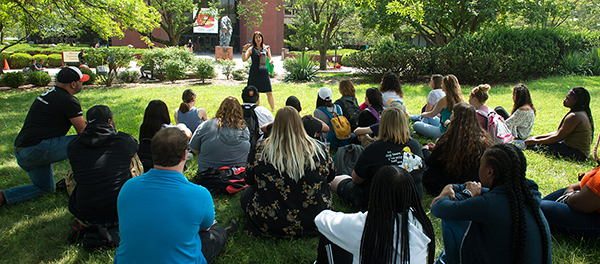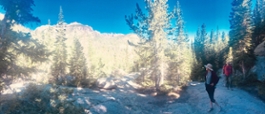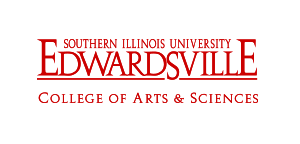|
|
|
The Sociology Program invites you to see....
|
|
|
|
Chair's Blog
I like to begin the semester asking students their ideas about human nature. More specifically, I ask them to consider whether humans are naturally more greedy or cooperative. When I pose the question, almost all students say, "Greedy!" To justify their responses, students often point to what they see as convincing evidence:
- Toddlers fight over toys.
- War has always existed.
- Gosh, at the very least, survival of the fittest!
We could tell many stories about human nature, but the one we choose to tell, that humans are naturally greedy, is not only empirically problematic, it’s also harmful.....(To read more)
|
|
|
|
Course Bio: Sociology for Careers and Life (390) |
|
| |
 |
|
|
|
Liz Stygar has been a wonderful mentor to our students over the years. She keeps helping us make sociology relevant, most recently by developing a class on careers for our majors. Here's her description of the class:
"So, you want to be a sociology major. What the heck are you going to do with that!?” Most of us do not start out as sociology majors, often choosing sociology after being inspired. Meanwhile, you may hear a comedian reference sociology as not being employable. We want to reassure our students they are indeed employable!
After graduating from SIUE in 2008 and teaching at the University for 10 years, Liz Stygar was ready to mentor students more formally. The Department of Sociology faculty was eager to invest in professionalization and job preparedness for our majors and minors. We want to shape them in ways that will maximize what they learn while being educated here at SIUE. Thus, the course Sociology for Careers and Life was born. Fall 2018 is the first time we are offering the course. We plan to offer the course again in upcoming fall semesters, and perhaps this course will become required for future students.
The Sociology for Careers and Life course is organized into three parts:
- The Successful Sociology Student: Students explicitly learn expectations of sociology faculty in many courses. We practice locating sociological research, properly citing, etc., early in the semester.
- Preparing for Jobs Related to Sociology: Students learn about job opportunities related to sociology. Resume and CV building, interview practice, etc., are assignment-related and practical job readiness tasks in the course.
- Application of Sociology and Public Sociology: At the end of the semester, students apply their sociological skills through hands-on assignments.
|
|
|
Get to Know Our Faculty: Ezra Temko |
|
| |
|
 |
|
|
What’s the Midwest like for a Northeasterner like you? Have you learned anything yet that has surprised you?
It’s been hot! Honestly, while I miss the ocean, living in Edwardsville with St. Louis half an hour away does not seem like too much of a change as of yet. Maybe the biggest difference–coming from Delaware and New Hampshire–is paying sales tax. I have learned:
- Avoid Imo’s.
- Horseshoes is not just a game or something for horses.
- Panera and St. Louis Bread Co. are one and the same.
I also never had to differentiate between alarms before – tornado sirens are new to me. I was surprised to find out my house is on top of a coal mine. My husband Drew is a hospice nurse and has found that the families he visits here in the Midwest are particularly kind. Liz Stygar is helping me learn to say Missouri properly (MizERee instead of MizORee).
Tell us a little about your research and what excites you most about it.
I research the change-making world of cultural politics, specifically with practical implications for changing symbolic politics, addressing structural power, and realizing social justice. I also am interested in social policy and K-12 education. I enjoy my research because it gives me an opportunity to make a positive difference and because I enjoy diving into understanding the complexities of social life and our ideas and meanings that impact policies and problems.
I am currently wrapping up research on an Iowa law requiring gender balance on state and local boards and commissions. The past year I have also helped the New Hampshire Women’s Foundation put together their Status of Women report. Next semester I plan to research local communities moving away from gender-specific events (e.g. Father-Daughter Dances becoming Family Dances). When I was living in Newmarket, New Hampshire, the community’s Daddy-Daughter Dance and Mommy and Me Tea events brought up a lot of emotions and complications for Drew and my two school-aged foster daughters. Edwardsville has gender-specific events like this. I plan to develop a resource for communities about the issue. If you would like to work with me, let me know!
I know you and your husband have a little one. Tell us about the most fun experience you’ve had with him since you’ve been here.
We have had many fun times together, from going to the St. Louis Zoo to exploring the SIUE gardens. Since he is 3½, he even thinks the Peck Hall stairwell is a fun adventure. I guess to single out one thing, and simultaneously give a plug for my upcoming spring class, Sociology of Drag, Lev really enjoyed going to the RuPaul’s Drag Race: Werq the World show last month at The Pageant in St. Louis. It was almost a disastrous experience because it was initially way too loud for Lev, but after he put in earplugs he really enjoyed the show. His favorites were Bob the Drag Queen and Kameron Michaels.
What do you love about SIUE so far?
I’m really grateful that the sociology department values applied sociology. It’s been great to be around so many faculty, staff, and students committed to social justice and to creating and holding an inclusive, supportive, and open environment. I love how on it some of my Sociology of Community Action students are with our grassroots fundraising efforts to support local families in need. We’ve raised over $3,000 so far this semester!
I appreciate that Indian food is regularly available at Center Court in the MUC. I appreciate my house’s proximity to campus and the clustered development design of the campus. I appreciate having open space and wildlife around. The SIUE Early Childhood Center (ECC) where my son goes to pre-school is terrific, and the SIUE Gardens is an amazing ‘community backyard’. I have not had any hostile geese encounters yet, though I did get a few mean looks. At the ECC the kids throw apples over the fence, resulting in regular visits from a deer they call Rosie.
|
|
|
Meet an Alum: James Campbell |
|
| |
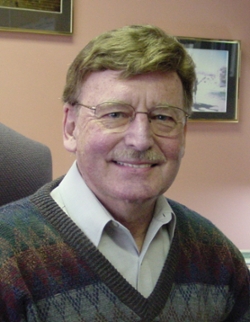 |
|
|
|
We are proud that one of our sociology alumni has been inducted into the SIUE Hall of Fame. James Campbell earned his bachelor's and master’s degrees in sociology from SIUE and his PhD in sociology from the University of Missouri-Columbia (UMC). Campbell began his career in education as an instructor in 1970 at Coe College in Cedar Rapids, Iowa, but he spent most of his career in the Department of Family and Community Medicine at UMC, from where he recently retired as emeritus professor. He was a pioneer in developing innovative curricula for medical students that incorporates the social and behavioral sciences. He played a key role in developing and implementing an innovative longitudinal inter-professional experience at UMC, and in developing videos that are widely used for training in educational institutions and public health departments. Additionally, Campbell and his wife, Anne, were instrumental in creating the Central Missouri Kidney Association, of which he is the president. Congratulations!
|
|
|
Undergraduate Student Showcase: Nikolle Danner |
|
| |
|
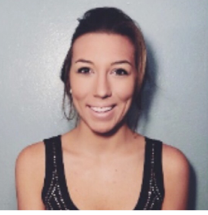 |
|
|
We love to feature the work of our students because frankly, we have some wonderful ones, and we enjoy sharing their insight, passion and intelligence. Below Nikolle Danner talks about her senior assignment project, titled, "Women's Representation Across Different Genres of Magazines Throughout History."
In U.S. society, the appearance of a woman is often how her value is measured. In order to understand what traits are valued as attractive we tend to turn towards the mass media. Our society is made up of many different people with many different interests, and the mass media accommodates our variety by having certain genres of magazines targeted towards certain audiences. For example, there are teen-focused, sports and current event magazines that display ads and pictures towards their intended audiences. While there have been multiple studies done of women’s appearances in the media, little research has been done on the representativeness across various genres of media.
For my research project I am studying how women are represented across different genres of magazines throughout history. The study will be focused on comparing how women are represented in the pictures not only across each type of magazine, but also how that magazine has evolved in representing women over time. Each magazine will be compared over a two decade difference in order to see the differences in how women were represented in the past as compared to now.
I will measure the women in the magazines by their race, age, skin to clothing ratio, the position of the model, and the roles the women are displaying in the photographs. This study will be looking at how each magazine will depict various types of women and measuring how each woman is being presented to its viewers.
|
|
|
Graduate Student Showcase: Adam Loesch |
|
| |
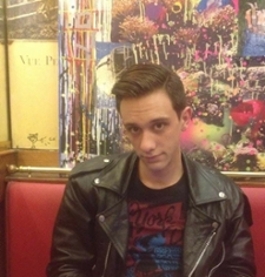 |
|
|
|
Adam Loesch is currently doing research on the Punk Scene. His study is entitled "Inclusion, Exclusion and Punk: A Field Analysis of Contemporary Subcultural Theory." It's an interesting study that looks at how those in the punk scene differentiate themselves. An abstract of his research is below.
Despite decades of research, the term ‘subculture’ remains fluid and ephemeral at best, the term ‘punk rock’ doubly so. To reframe the conversation about subculture in to a more viable framework, I selected inclusion and exclusion criteria as the primary focus of research to eschew preconceived assumptions associated with any particular sociological term or paradigm. Rather than look for a difference between past and present, the point was to look for the specific, real-time processes by which subcultures function. I completed semiotic analysis of interview responses with those in the Punk scene. My findings indicate a physical emphasis on inclusion/exclusion. Very precise signs such as gait, jargon, and body language demonstrated an exclusionary method that was based on physicality and is transmitted to an online presence. In an era where one can merely interact with members of the community online and never be present for a single performance, this successful negotiation of physical reality and online presence becomes the primary tool for determining who is “in”. In order to negotiate both the online community and the lived community one has to consistently engage in both or the other will be lost in translation. It naturally follows that this approach is not limited to punk, rather this approach accounts for fusion and movement between several genres and an overall method of navigating any and all cultural landscapes against the narrower backdrop of “punk rock”.
|
|
|
Thinking about Sociology: Readings You May Enjoy |
|
| |
|
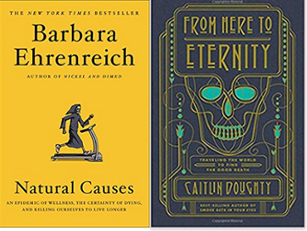
We are a society that feels death is something someone else does or isn't important to contemplate. These readings suggest otherwise. They take a sociological reflection on health, well being and how we can be more thoughtful about our dying, ultimately helping us live a little more fully.
From Here to Eternity by Caitlin Doughty
"Doughty, the founder of the Order of the Good Death, a nonprofit organization that advocates for natural burial and reducing the stigma around death, describes funereal rituals around the world while stopping to reflect on U.S. practices. In Indonesia, for instance, the Toraja keep the dead at home for several months or years until the funeral. The author also explores North Carolina's FOREST facility, which composts corpses, and the Crestone End of Life, a Colorado nonprofit that performs open-air cremations. Doughty shares her reverence for the dead while poking fun at our fears ("gross as it sounds, I'd come back from the dead for a Diet Coke"). She forces U.S. readers to confront the secretive and profitable mortuary business and sheds light on cultures that celebrate death. If death is inevitable, she asks, why are we afraid to address it? As the Bolivians look to their natitas (special human skulls), we can look to them for a level of comfort and familiarity with death. "How would your ancestors deal with tragedy?" Probably not with a $10,000 check to take a dead body away. VERDICT Recommend this fascinating and well-written book to fans of Mary Roach's Stiff: The Curious Lives of Human Cadavers."
—Pamela Schembri, Horace Greeley High School, Chappaqua, NY
Natural Causes: Life, Death and the Illusion of Control by Barbara Ehrenrich
"We tend to believe we have agency over our bodies, our minds and even our deaths. Yet emerging science challenges our assumptions of mastery: at the microscopic level, the cells in our bodies facilitate tumours and attack other cells, with life-threatening consequences. In this revelatory book, Barbara Ehrenreich argues that our bodies are a battleground over which we have little control, and lays bare the cultural charades that shield us from this knowledge. Challenging everything we think we know about life and death, she also offers hope - that we find our place in a natural world teeming with animation and endless possibility."
|
|
|
|
